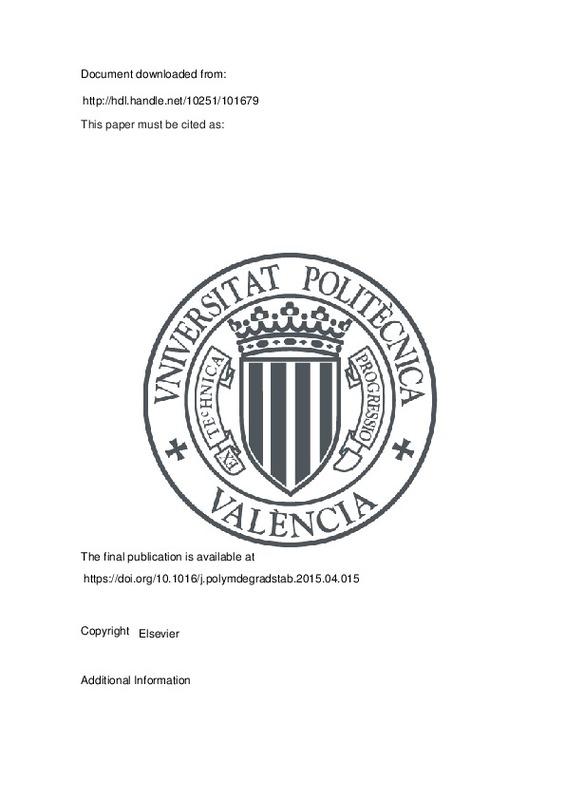JavaScript is disabled for your browser. Some features of this site may not work without it.
Buscar en RiuNet
Listar
Mi cuenta
Estadísticas
Ayuda RiuNet
Admin. UPV
Effects of hydroxyapatite filler on long-term hydrolytic degradation of PLLA/PCL
Mostrar el registro sencillo del ítem
Ficheros en el ítem
| dc.contributor.author | Ródenas Rochina, Joaquín
|
es_ES |
| dc.contributor.author | Vidaurre, Ana
|
es_ES |
| dc.contributor.author | Castilla Cortázar, María Isabel Cecilia
|
es_ES |
| dc.contributor.author | Lebourg ., Myriam Madeleine
|
es_ES |
| dc.date.accessioned | 2018-05-10T04:19:41Z | |
| dc.date.available | 2018-05-10T04:19:41Z | |
| dc.date.issued | 2015 | es_ES |
| dc.identifier.issn | 0141-3910 | es_ES |
| dc.identifier.uri | http://hdl.handle.net/10251/101679 | |
| dc.description.abstract | [EN] Poly(L-lactic acid)(PLLA)/poly(epsilon-caprolactone)(PCL)/hydroxyapatite(HAp) composites appear as promising materials for healing large bone defects. Highly porous PLLA/PCL scaffolds, 80/20, 20/80 weight ratios, porosity >85%, were prepared by a dual technique of freeze extraction and porogen leaching, with and without HAp. A double pore structure was obtained, with interconnected macroporosity together with interconnected microporosity. Subsequent long-term (78 weeks = 1.5 years) hydrolytic degradation behavior was investigated in terms of the samples' mechanical properties, molecular weight (M-w), mass changes, thermal characteristics, X-ray Diffraction and Thermogravimetric Analysis. Elastic modulus and yield strength of as-synthesized scaffolds were higher for PLLA rich blends and including the inorganic phase does not lead to a mechanical strengthening in these materials. Nevertheless, after 30 weeks of degradation, PLLA rich scaffolds lost more than half of their strength and rigidity. On the contrary, the densification modulus of the PLLA based blends increased with degradation time, whereas PCL-based blends had a relatively constant densification modulus. PCL-based samples showed lower hydrolysis coefficients k than PLLA-based samples, as expected from the higher density of ester bonds in the latter. Interestingly, although including HAp leads to a lower hydrolysis coefficient k in PCL rich samples, it increases k in the PLLA-based sample, which is consistent with the other results obtained. | es_ES |
| dc.description.sponsorship | The authors are grateful for the support of the Biomedical Research Networking Center in Bioengineering, Biomaterials, and Nanomedicine, an initiative funded by the VI National R&D&i Plan 2008-2011, Iniciativa Ingenio 2010, and Consolider Program. J. Rodenas-Rochina acknowledges the funding of his PhD by the Valencian Generality through VALi+d grant. | en_EN |
| dc.language | Inglés | es_ES |
| dc.publisher | Elsevier | es_ES |
| dc.relation.ispartof | Polymer Degradation and Stability | es_ES |
| dc.rights | Reserva de todos los derechos | es_ES |
| dc.subject | Hydroxyapatite | es_ES |
| dc.subject | Poly(L-lactic acid) | es_ES |
| dc.subject | Poly(epsilon-caprolactone) | es_ES |
| dc.subject | Polyester blends | es_ES |
| dc.subject | Long term hydrolytic degradation | es_ES |
| dc.subject | Hydrolysis coefficient | es_ES |
| dc.subject.classification | INGENIERIA QUIMICA | es_ES |
| dc.subject.classification | TERMODINAMICA APLICADA (UPV) | es_ES |
| dc.subject.classification | FISICA APLICADA | es_ES |
| dc.subject.classification | MAQUINAS Y MOTORES TERMICOS | es_ES |
| dc.title | Effects of hydroxyapatite filler on long-term hydrolytic degradation of PLLA/PCL | es_ES |
| dc.type | Artículo | es_ES |
| dc.identifier.doi | 10.1016/j.polymdegradstab.2015.04.015 | es_ES |
| dc.rights.accessRights | Abierto | es_ES |
| dc.contributor.affiliation | Universitat Politècnica de València. Centro de Biomateriales e Ingeniería Tisular - Centre de Biomaterials i Enginyeria Tissular | es_ES |
| dc.contributor.affiliation | Universitat Politècnica de València. Departamento de Física Aplicada - Departament de Física Aplicada | es_ES |
| dc.description.bibliographicCitation | Ródenas Rochina, J.; Vidaurre, A.; Castilla Cortázar, MIC.; Lebourg ., MM. (2015). Effects of hydroxyapatite filler on long-term hydrolytic degradation of PLLA/PCL. Polymer Degradation and Stability. 119:121-131. doi:10.1016/j.polymdegradstab.2015.04.015 | es_ES |
| dc.description.accrualMethod | S | es_ES |
| dc.relation.publisherversion | https://doi.org/10.1016/j.polymdegradstab.2015.04.015 | es_ES |
| dc.description.upvformatpinicio | 121 | es_ES |
| dc.description.upvformatpfin | 131 | es_ES |
| dc.type.version | info:eu-repo/semantics/publishedVersion | es_ES |
| dc.description.volume | 119 | es_ES |
| dc.relation.pasarela | S\291868 | es_ES |
| dc.contributor.funder | Ministerio de Ciencia e Innovación |







![[Cerrado]](/themes/UPV/images/candado.png)

